You are hereWcP.Scientific.Mind's blog
WcP.Scientific.Mind's blog
Pushing the Edge of Science - Growing Electronics with Viruses, Finding Alien Life, and Quantum Cryptography
(quote)
Angela Belcher
Edge work: “Programming” viruses to perform useful tasks
Why? It is clean and efficient.
Where? MIT
Initial response: “I was called insane.”
In a series of experiments at MIT, Belcher, working with a team of about 30 students and postdocs, has successfully programmed viruses to incorporate, then grow, a variety of inorganic materials, including nanoscale semiconductors, solar cells, and magnetic storage materials. Separately, she is using yeasts as scaffold organisms because of their ability to grow many different materials. “We look at yeasts as factories,” she explains. “Instead of Budweiser, there’s Nanoweiser.” Belcher has begun working with the U.S. Army on nanoscale batteries that would weigh a fraction of what current batteries weigh and be woven into a soldier’s uniform. She is also training viruses to “find mistakes in materials and give off a signal.” One possible application: spraying viruses on an airplane fuselage to check for microscopic defects. In addition, the National Cancer Institute is funding Belcher to use viruses to find peptides that can specifically identify cancer cells.
Dimitar Sasselov
Edge work: Finding life on planets outside our solar system
Why? We have to know.
Where? Harvard University
Initial response: “People are always very excited.” read more »
Cellulosic Ethanol Plant Opens, Uses Waste Biomass to Make Biofuel
Original Source: Technology Review
(quote)
A biorefinery built to produce 1.4 million gallons of ethanol a year from cellulosic biomass will open tomorrow in Jennings, LA. Built by Verenium, based in Cambridge, MA, the plant will make ethanol from agricultural waste left over from processing sugarcane. It is the first demonstration-scale cellulosic ethanol plant in the United States and will be used to try out variations on the company's technology and is designed to run continuously. Verenium wants to demonstrate that it can create ethanol for $2 a gallon, which it hopes will make the fuel competitive with other types of ethanol and gasoline. Next year, the company plans to begin construction on commercial plants that will each produce about 20 to 30 million gallons of ethanol a year. Until now, technology for converting nonfood feedstocks into ethanol has been limited to the lab and to small-scale pilot plants that can produce thousands of gallons of ethanol a year. Since these don't operate continuously, they don't give an accurate idea of how much it will ultimately cost to produce cellulosic ethanol in a commercial-scale facility.
Almost all ethanol biofuel in the United States is currently made from corn kernels. But the need for cellulosic feedstocks of ethanol has been underscored recently as food prices worldwide have risen sharply, in part because of the use of corn as a source of biofuels. At the same time, the rising cost of corn and gas have begun to make cellulosic ethanol more commercially attractive, says Wallace Tyner, a professor of agricultural economics at Purdue University. A new Renewable Fuels Standard, part of an energy bill that became law late last year, mandates the use of 100 million gallons of cellulosic biofuels by 2010, and 16 billion by 2022.
So far, however, there are no commercial-scale cellulosic ethanol plants in operation in the United States, although a number of facilities are scheduled to start production in the next few years. The Department of Energy is currently funding more than a dozen companies that will be building demonstration- and commercial-scale plants. One of these, Range Fuels, based in Broomfield, CO, plans to open a commercial-scale plant next year. It will have the capacity to produce 20 million gallons of ethanol and methanol a year. Verenium will use a combination of acid pretreatments, enzymes, and two types of bacteria to make ethanol from the plant matter--called bagasse--that's left over from processing sugarcane to make sugar. It will also process what's called energy cane, a relative of sugarcane that's lower in sugar and higher in fiber. The high fiber content allows the plants to grow taller, increasing yield from a given plot of land.
The opening of the demonstration plant, and the current construction of a number of other demonstration- and commercial-scale cellulosic ethanol plants, marks a turning point for the industry, Riva says. The development of improved enzymes and fermentation organisms means that no further scientific breakthroughs are needed to make cellulosic ethanol commercially successful, he says. "There's been a tremendous amount of background work in science and technology development," he says. "We've learned so much about the process that the really important thing now is to start to deploy the technology at a commercial scale."
(unquote)
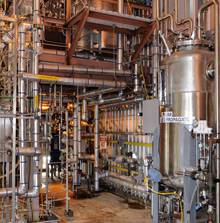
NASA Mars Probe Prepares for Risky Landing
Original Source: BBC News
(quote)
The Phoenix lander is due to touch down on Monday in the far north of the Red Planet, after a 423-million-mile journey from Earth. The probe is equipped with a robotic arm to dig for water ice thought to be buried beneath the surface. Scientists say the mission should give the clearest indication yet of whether Mars could once have harbored life.
The final seven minutes of the probe's ten-month journey is regarded as the riskiest part of the mission. After it enters the top of the Martian atmosphere at nearly 5.7km/s (13,000 mph), the probe must perform a series of maneuvers to come safely to rest. It will release a parachute, use pulsed thrusters to slow to a fast walking speed, then come to a halt on three legs. If all goes to plan, the Phoenix lander will reach the surface of Mars at 0053 BST (1953 EDT) on May 26. Nasa controllers will know in about 15 minutes whether the attempt has been successful.
Landing on Mars is a notoriously tricky business. Of the 11 missions that have tried to land probes on Mars since 1971 - only five have succeeded. Phoenix is an apt name for the current mission, as it rose from the ashes of two previous failures. In September 1999, the Mars Climate Orbiter spacecraft crashed into the Red Planet following a navigation error caused when technicians mixed up "English" (imperial) and metric units. A few months later, another Nasa spacecraft, the Mars Polar Lander (MPL), was lost near the planet's South Pole. Phoenix uses hardware from an identical twin of MPL, the Mars Surveyor 2001 Lander, which was cancelled following the two consecutive failures. The probe was launched on 4 August 2007 on a Delta II rocket from Cape Canaveral Air Force Station in Florida.
(unquote)

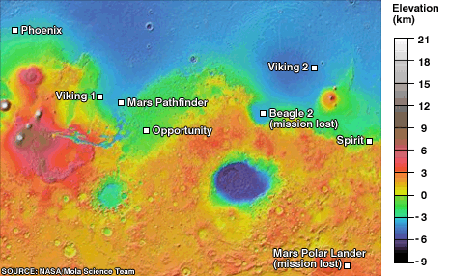
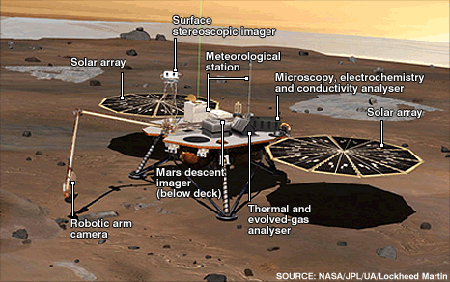
Scientists Observe Birth of a Supernova, Captured on Camera For the First Time
Original Source: Spaceflight Now
(quote)
PRINCETON, NJ -- When she peered into the screen of her computer one day in January, Alicia Soderberg was supposed to see a small, dull glowing smudge in one corner, the evidence of a month-old supernova that would help her better understand the mystery of these huge exploding stars. What the Princeton University astronomer saw instead was anything but dull. As Soderberg and Edo Berger, a postdoctoral research associate at Princeton, studied the X-ray emissions conveyed from space by NASA's Swift satellite, they saw an extremely bright light that seemed to jump out of the sky. They didn't know it, but they had just become the first astronomers to have caught a star in the act of exploding. The once-in-a-lifetime event, described in a paper published in the May 22 issue of Nature, has transfixed the worldwide astronomical community.
Soderberg and Berger wanted to observe a supernova known as SN 2007uy in the spiral galaxy NGC 2770, located 90 million light years from Earth in the constellation Lynx. They could plan to do that because they are able to view images captured by the telescope a few hours after the observation merely by downloading the data from the Swift website. The sudden appearance nearby of the X-ray burst of the newer supernova, easily captured by the NASA satellite with multiple instruments that can detect gamma rays, X-rays and ultraviolet light, has set scientists on a new path. "This phenomenon had been predicted more than 30 years ago, but is now observed for the first time," said Roger Chevalier, the W.H. Vanderbilt Professor of Astronomy at the University of Virginia. "These are the earliest observations of light from a supernova after the central collapse that initiated the explosion."
In the Nature paper, Soderberg and 38 colleagues show that the energy and pattern of the X-ray outburst is consistent with what scientists would have expected to see in the birth of a neutron star -- a shock wave blasting through the surface of the original massive star. Until now, astronomers have only been able to observe supernovae brightening days or weeks after the event, when the expanding shell of debris is energized by the decay of radioactive elements forged in the explosion.
(unquote)
Photos Courtesy of AFP and NASA/Swift Science Team/Stefan Immler
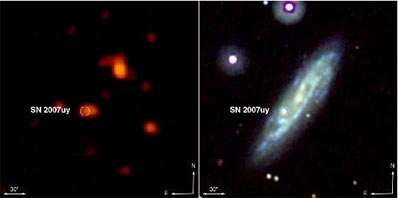
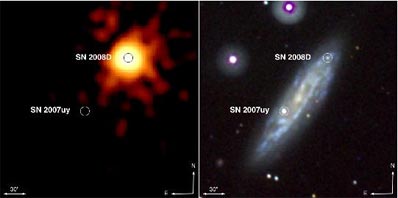
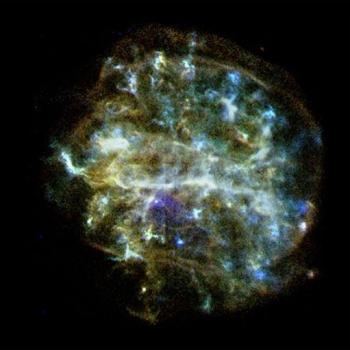
Hubble Photos: Galactic Collisions

(quote)
To celebrate the 18th anniversary of the Hubble Space Telescope launch, the Space Telescope Science Institute has released 59 beautiful images of galaxies spinning and colliding into each other.
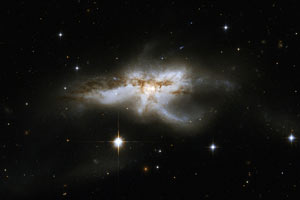

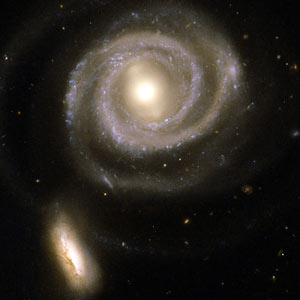
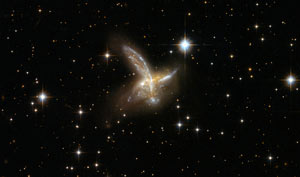
About Hubble
The Hubble Space Telescope is a collaboration between ESA and NASA. It's a long-term, space-based observatory. The observations are carried out in visible, infrared and ultraviolet light. In many ways Hubble has revolutionised modern astronomy, by not only being an efficient tool for making new discoveries, but also by driving astronomical research in general.
The mission
The Universe is gloriously transparent to visible light over journeys lasting billions of years. However, in the last few microseconds before light arrives at telescope mirrors on Earth it must travel through our turbulent atmosphere and the fine cosmic details become blurred. It is this same atmospheric turbulence that makes the stars appear to twinkle on a dark night. read more »
Honda's ASIMO Robot to Conduct Detroit Symphony Orchestra

"Honda will also partner with the Detroit Symphony Orchestra over the next five years to offer training in string instruments, a scholarship program, an educational concert series, support for live classical performances and a fundraiser."
Photo courtesy Wired


















